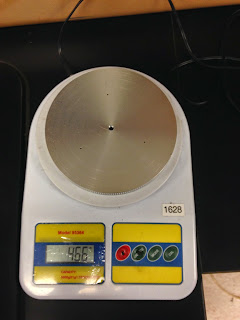To release a meter stick, pivoted at one end, so that it swings and collides inelastically with a blob of clay and to record the height the clay at the end of the stick reaches.
To find the theoretical height the clay reaches using calculations from conservation of energy and conservation of angular momentum.
To compare these results.
Set-Up:
The apparatus consist of a meter stick hanging from one pivoted end and piece of clay with tape of negligible mass wrapped around it so that the meter stick inelastically collides with the clay.
 |
| Clay lined up so that it's cm is nearly at the very tip of the stick |
Experiment:
1. First we needed to collect all the measurable data such as the weight of the clay and meter stick at its center of mass.
 |
| Mass of Clay = 25.3 grams |
2. To perform the experiment we lifted the meter stick until it was parallel to the ground and set our pivot point as our GPE=0.
3. We then recorded, on video capture, the dropping of the meter stick going from full GPE to all KE and then inelastically colliding the piece of clay, rising a specific height.
Data Analysis:
1. To start, we analyzed the video capture data to figure out how high the meter stick raised after inelastically colliding with the piece of clay, shown below:
 |
| Height of clay reached above the ground = 0.2904 meters |
2. Next we needed to find the theoretical height the clay would reach through analyzing the scenario through three separate phases.
First, we looked at the switch of energy from potential to kinematic of the meter stick to find the angular velocity of its center of mass, just before the collision with the clay.
 |
| Omega of Ruler = 6.067 rad/s |
Second, we used this omega as the initial omega and used momentum to find the final omega after the collision of the mass and clay.
 |
| Omega of Clay and Ruler = 3.170 rad/s |
 |
| Theoretical height reached by clay = 0.401 m |
% Error:
|(Theoretical height-Actual height reached by clay)|/Theoretical height *100% = percent error
|(0.401-0.290)|/(0.401) * 100% = 27.58%
Conclusion:
When finding the theoretical height through conservation of energy and angular momentum we estimated the clay to rise 0.401 meters off the ground when in reality it rose 0.290 meters. Although our percent error was roughly 25% off, it was not surprising the actual height reached would be less than predicted. Although the energy was conserved, there were many factors not taken into account when finding the theoretical height, such as loss of energy due to heat and friction of the pivot (let alone human error such as not using the correct number of sigfigs). The experiment was successful is proving to us the conservation of angular moment and conservation of energy.



























































